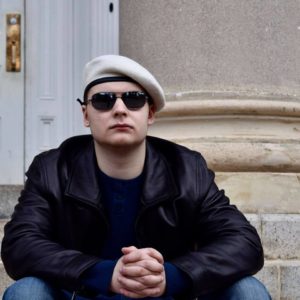 In case you missed it, a hashtag started by a rising sophomore at UMW went viral — and landed the student, Andrew Schneidawind, a mention in almost every major news outlet in the nation, including an interview on CNN’s headline news.
In case you missed it, a hashtag started by a rising sophomore at UMW went viral — and landed the student, Andrew Schneidawind, a mention in almost every major news outlet in the nation, including an interview on CNN’s headline news.
Here’s the story, which first ran on UMW’s home page:
UMW Student’s Tweet Heard Around the World
On Sunday afternoon, May 20, 18-year-old Andrew Schneidawind sat in his Arlington, Virginia, bedroom and looked at the two computer monitors in front of him.
Two days had passed since a Texas high school student opened fire on classmates, killing 10 and wounding more than a dozen, the latest in a string of mass shootings in America.
What, Schneidawind wondered, could he do to make a difference? He stared at his Twitter account. It would need to be provocative, he thought, if it was going to catch on. Then it came to him.
“I’m gonna try and get a hashtag trending called #IfIdieInASchoolShooting,” he typed. “If you wanna join, feel free.”
Then Schneidawind, who’d just finished his freshman year at the University of Mary Washington, typed out the things he’d never get to do if it happened to him.
“IfIdieInASchoolShooting, I will never be able to finish my animated TV series, I’ll never be able to see my sister again, and I will have to become a martyr. #NeverAgain,” he wrote to 150 followers. He settled in to wait.
He didn’t have to wait long. Over the next three hours, Schneidawind watched nervously as the hashtag took off. Over the next three days, he was fielding interview requests from Teen Vogue to The Washington Post, and the hashtag had been used more than 50,000 times.
“I was just a small, aspiring activist,” Schneidawind told UMW four days later as he prepared for an afternoon interview on CNN.
“Now I’m always going to be known as the guy who started #IfIdieInASchoolShooting.”
Sandy Hook to Parkland
Schneidawind is not happy about that. To be known for a hashtag about dying in a school shooting is to acknowledge that people die in school shootings. Even if the statistical odds are exceedingly rare.
As he watched the likes on his Twitter post climb into the thousands, as he stepped into a Dunkin’ Donuts near the construction site in Arlington where he works a summer job to take phone call after phone call, his initial excitement waned.
“It hits you. You had to make [the hashtag] because of this problem. I wasn’t regretting it. But I wasn’t ever really happy I started it,” the communications and digital studies major said.
He can recall the deadliest mass shootings since Sandy Hook Elementary School, when a gunman killed 26, 20 of them children, in 2012.
Schneidawind was 12.
“I remember it all.”
He remembers the proposed gun legislation that later failed, including a bill that would have reinstated an expired 1994 assault weapons ban. He remembers the mass shootings that followed – Charleston, Orlando, Las Vegas. He watched it unfold on TV and computer screens.
When 17 people died at Marjory Stoneman Douglas High School in Parkland, Florida, in February, Schneidawind had had enough of watching.
“I went to Florida. It was important to me.”
He stayed for two days. “I always knew it was real. When I did see it, it was more real than I ever expected.”
Making waves
Three months later, there had been another school shooting – this time in Texas.
Even though he had followed the news of mass shootings in America since he was 12, Andrew Schneidawind said the February shooting at a high school in Parkland, Florida that left 17 dead changed him.
“It planted a seed. That seed has grown.”
Which is how he found himself sitting in front of his computer days after wrapping up his first year at Mary Washington, which he’d chosen for its proximity to home, for the prettiness of the campus and the pleasantness of the people.
“I was just a small puddle in the ocean,” he said.
Now he was making waves.